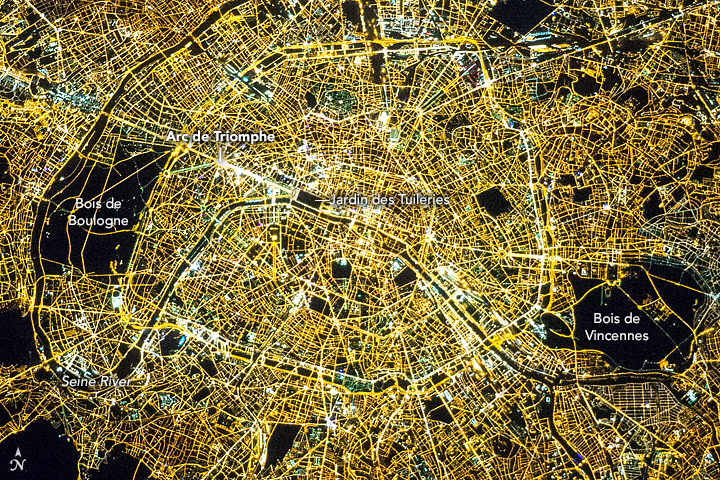

Around local midnight, astronauts aboard the International Space Station took this photograph of Paris, often referred to as the “City of Light.” The second image below is a close-up drawn from the same photo.
The pattern of the street grid dominates at night, providing a completely different set of visual features from those visible during the day. For instance, the winding Seine River is a main visual cue by day, but here the thin black line of the river is hard to detect until you focus on the strong meanders and the street lights on both banks.
The brightest boulevard in the dense network of streets is the Avenue des Champs-Élysées, the historical axis of the city, as designed in the 17th century. Every year on Bastille Day (July 14), the largest military parade in Europe processes down the Champs Élysées, reviewed by the President of the Republic. This grand avenue joins the site of the former royal Palace of the Tuileries—whose gardens appear as a dark rectangle on the river—to the star-like meeting place of eleven major boulevards at the Arc de Triomphe. This famous plaza is also referred to as the Étoile, or “star.”.

The many forested parks of Paris stand out as black polygons—such as the Bois de Boulogne and Vincennes. The Bois de Boulogne is criss-crossed by a few roads and lighted paths.
In the wide view, Orly and Charles de Gaulle airports are distinguished by their very bright lights next to the dark areas of runways and surrounding open land. Paris’s great ring road, the Boulevard Périphérique, encloses the city center.
A regional, night view taken by astronauts shows much of northwest Europe, with Paris and London as the largest light clusters.
Astronaut photograph ISS043-E-93480 was acquired on April 8, 2015, with a Nikon D4 digital camera using a 400 millimeter lens, and is provided by the ISS Crew Earth Observations Facility and the Earth Science and Remote Sensing Unit, Johnson Space Center. The image was taken by a member of the Expedition 43 crew. The image has been cropped and enhanced to improve contrast, and lens artifacts have been removed. The International Space Station Program supports the laboratory as part of the ISS National Lab to help astronauts take pictures of Earth that will be of the greatest value to scientists and the public, and to make those images freely available on the Internet. Additional images taken by astronauts and cosmonauts can be viewed at the NASA/JSC Gateway to Astronaut Photography of Earth. Caption by M. Justin Wilkinson, Texas State University, Jacobs Contract at NASA-JSC.